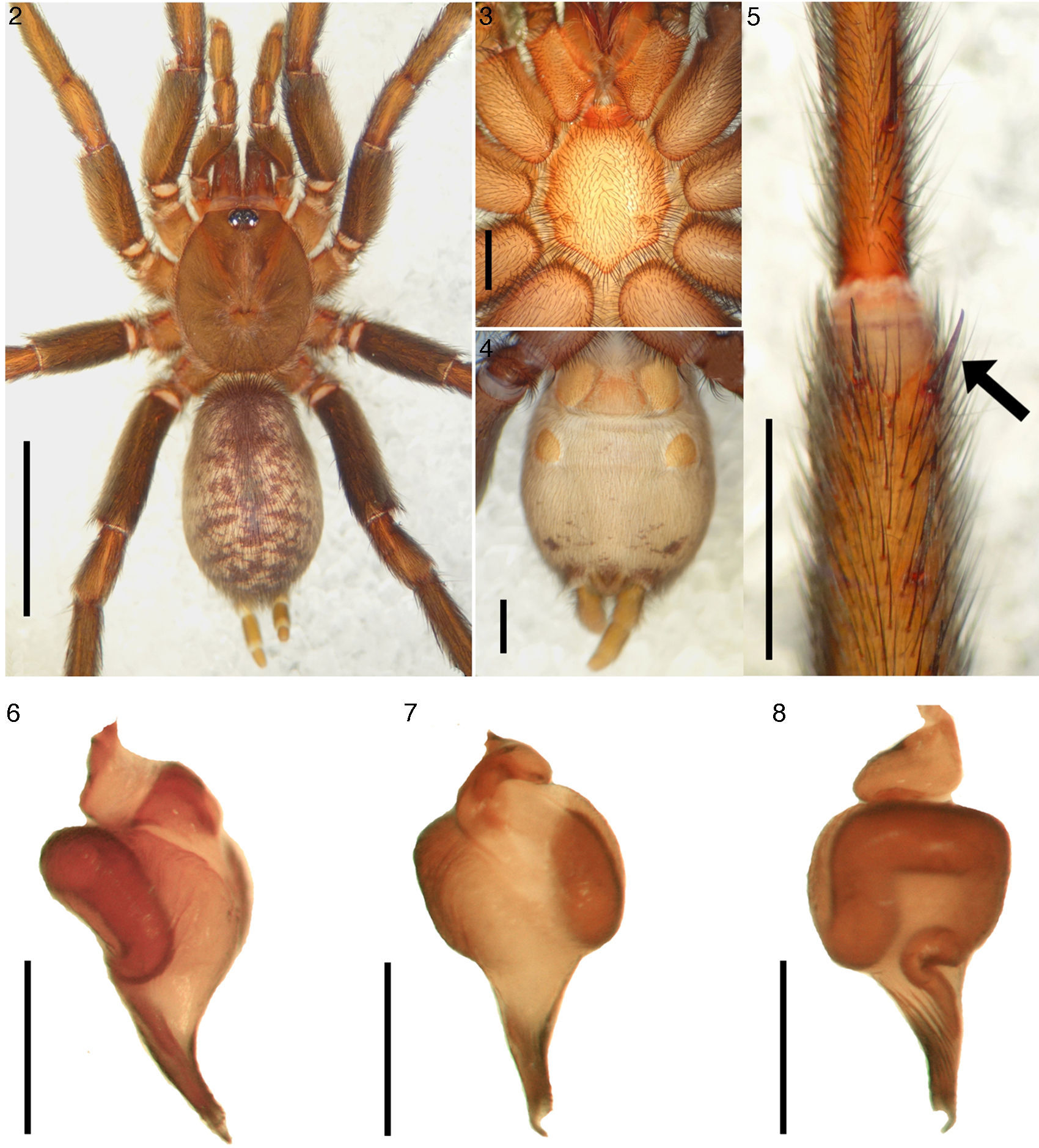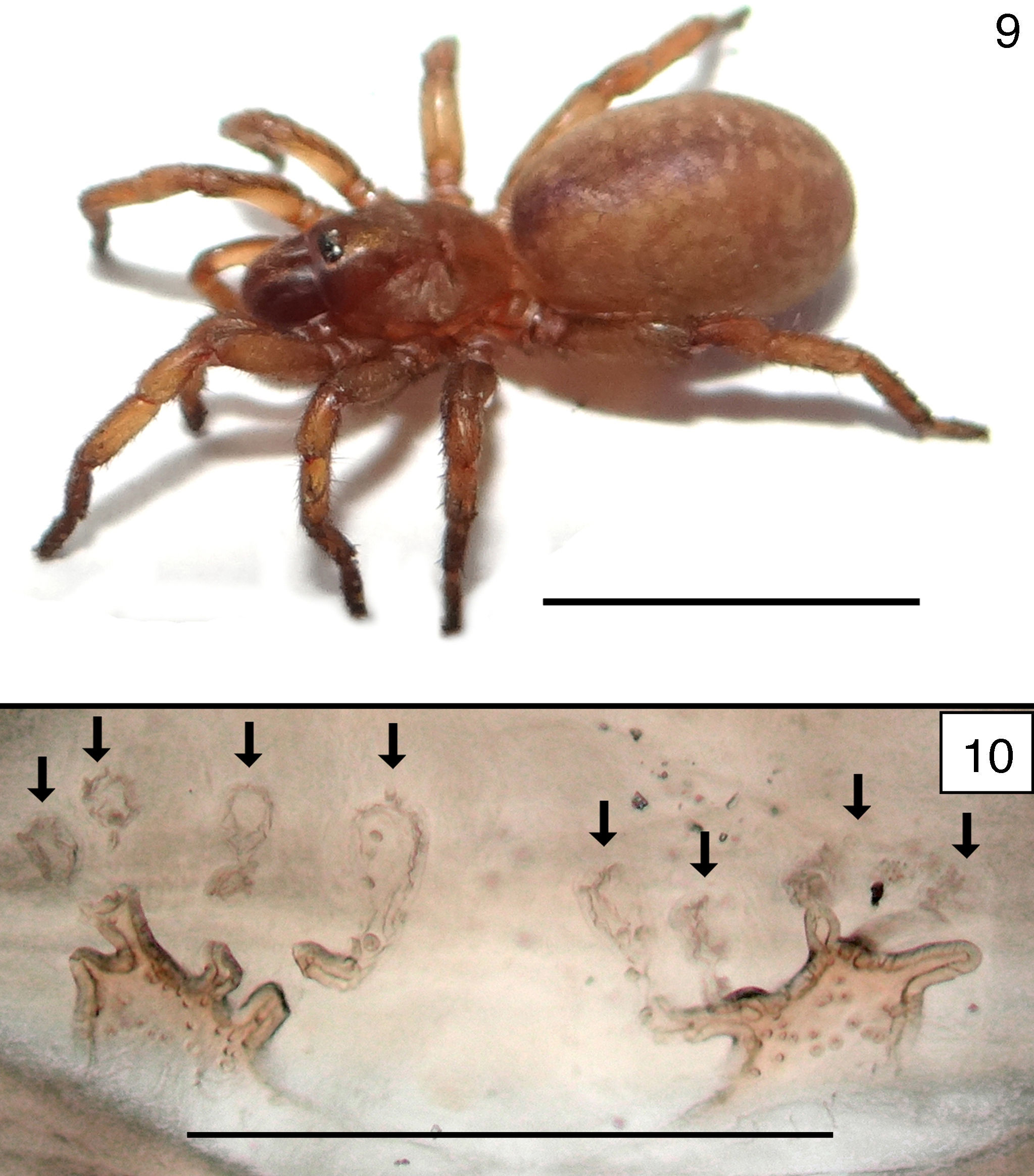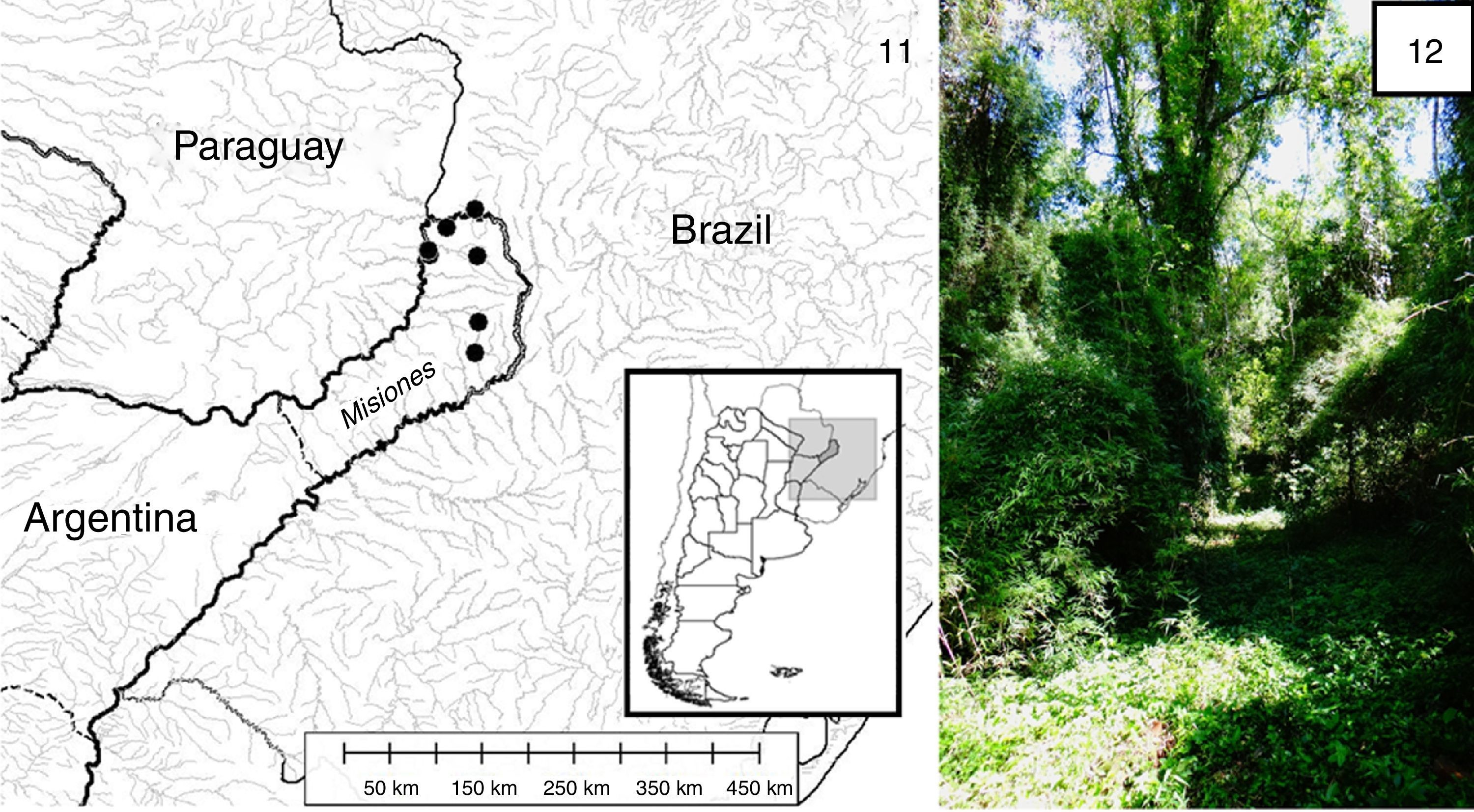The male of Stenoterommata uruguaiGoloboff, 1995 is described and illustrated for the first time. A photograph of a female spermathecae collected at the same locality is also presented to confirm the identification, as well as data on the natural history of this species.
Se describe e ilustra por primera vez el macho de Stenoterommata uruguaiGoloboff, 1995. También se presenta una fotografía de la espermateca de una hembra recolectada en la misma localidad para confirmar la identificación y se registran datos sobre la historia natural de esta especie.
To date, the Nemesiidae comprises 382 species and 45 genera (World Spider Catalog, 2015). This family includes medium-sized, as well as small-sized spiders (Goloboff, 1995; Montes de Oca & Pérez-Miles, 2013). The Nemesiidae are distributed worldwide and are divided into 6 subfamilies, of which, 4 occur in the Neotropical region: Anaminae, Diplothelopsinae, Nemesiinae and Pycnothelinae (including the genus StenoterommataHolmberg, 1881) (Goloboff, 1995; Raven, 1985).
Stenoterommata was established by Holmberg (1881), based on S. platensisHolmberg, 1881, from Argentina. The genus includes 13 nominal species, distributed in Argentina, Brazil and Uruguay (Guadanucci & Indicatti, 2004; World Spider Catalog, 2015). Spiders of this genus are recognized by having a row of enlarged pumpkiniform spigots along the inner edge of posterior lateral spinnerets spinning field, in conjunction with preening combs on the female metatarsi II, and numerous maxillary cuspules; the male tibia has an apical retrolateral megaspine, and the bulb has several low parallel keels along the embolus (Goloboff, 1995). Goloboff (1995) revised the species from Argentina and he concluded that the distribution of the genus includes the provinces of Buenos Aires, Catamarca, Entre Ríos, Santa Fé, Misiones and Salta. Stenoterommata species live in burrows, constructed under logs, stones or in open spaces, commonly along rivers or streams; others species can live in flat, floodable terrains (Goloboff, 1995; Schwerdt & Copperi, 2014). The burrows are open, usually prolonged with silk and sometimes attached to fallen leaves or branches (Schwerdt & Copperi, 2014).
Recent collecting efforts in Misiones province under a research program funded by the Rufford Small Grants Foundation focused on ‘tarántula’ conservation enabled us to observe and document many specimens of Stenoterommata. In this contribution we describe for the first time the male of Stenoterommata uruguaiGoloboff, 1995 and present some data on its natural history.
The following abbreviations are used: ALE, anterior lateral eyes; AME, anterior median eyes; D, dorsal; ITC, internal tarsal claw; OQ, ocular quadrangle; P, prolateral; PLE, posterior lateral eyes; PLS, posterior lateral spinnerets; PME, posterior median eyes; PMS, posterior median spinnerets; R, retrolateral; STC, superior tarsal claw. All measurements are given in millimeters and were taken with digital dial calipers with an error of 0.01mm, and with an Olympus stereoscopic microscope equipped with a calibrated ocular micrometer scale. Lengths of leg articles were taken from left limbs in the dorsal view from the mid-proximal point of articulation to the mid-distal point of the article (sensuCoyle, 1995, fig. 1; Bond, 2012, figs. 11–16). Eyes sizes were taken from maximum diameters. Spine and tarsal claw teeth notations follow Goloboff (1995). Photographs of preserved material were taken with a digital camera SONY Hx200v. The spermathecae from a female was dissected and cleared with lactic acid for 30min and photographed under a high resolution Micrometrics camera attached to a Nikon Eclipse 600 microscope. Spine notation follows Goloboff (1995).
The material studied is deposited in the Laboratorio de Zoología de Invertebrados II, Universidad Nacional del Sur (LZI), Bahía Blanca, Buenos Aires, Argentina.
Other material examined. Stenoterommata iguazuGoloboff, 1995. Argentina: Misiones Province. Oberá department, Centro de Investigaciones “Antonia Ramos” (27°26′39.8″ S, 54°56′23.2″ W). 4 females (LZI0346), 1.V.2014, N. Ferretti col. 1 male (LZI0390), same data as females. Iguazú, Parque Nacional Iguazú (25°31′5″ S, 54°8′2″ W), 1 male (LZI0330), 27.IX.2014.
Stenoterommata uruguaiGoloboff, 1995 (Figs. 1–10)Stenoterommata uruguaiGoloboff, 1995: 64, fig. 68; female holotype from Parque Nacional Iguazú, Misiones province, Argentina; VII.1983; P. Goloboff col; deposited in Museo Argentino de Ciencias Naturales Bernardino Rivadavia (MACN-Ar); not examined.
Diagnosis (emended). Males of S. uruguai differ from those of all other species of the genus (except from Stenoterommata arnolisei, Stenoterommata grimpa and Stenoterommata curiy) by having a very short embolus. They differ from S. arnolisei by the keels restricted to the apical region. Males of S. uruguai resemble S. curiy by the translucent keels but can be distinguished from this species and from S. grimpa by the hooked-shape embolus (Figs. 6–8). The females of S. uruguai resemble those of S. arnolisei, Stenoterommata crassistyla, Stenoterommata quena, by the shape of the spermathecae, consisting in single dome bearing the receptacles (Fig. 10), but differ from S. arnolisei by having multireceptaculate spermathecae and from S. crassistyla and S. quena by the wider and more rounded basal dome.
Stenoterommata uruguai. Male (LZI0350). (2) Carapace and abdomen, dorsal view; scale=0.5mm. (3) Labium and stenum, ventral view; scale=1mm. (4) Abdomen, ventral view; scale=1mm. (5) Left tibia I, ventral view (arrow pointing to megaspine); scale=1mm. (6) Palpal bulb, retrolateral view; scale=1mm. (7) Same, ventral view. (8) Same, prolateral view.
Material examined. Argentina: Misiones province, General Manuel Belgrano department, Bernardo de Irigoyen, Urugua-í Wildlife Reserve (25°58′33.1″ S, 54°06′46.9″ W). 1 Male (LZI0350), 4.X.2014, G. Pompozzi col., collected as juvenile, molted to adult at laboratory on 7.III.2015 (LZI0350); 1 female (LZI0331) and 1 juvenile (LZI0349), same data as male.
Description. Male (LZI0350). Color: carapace, legs and palpi, reddish brown; abdomen yellowish brown with dark mottles forming many chevrons (Figs. 1, 2 and 4). Total length: 11.5. Carapace 5.5 long, 4.6 wide. Abdomen 6.1 long, 3.3 wide. Clypeus narrow, 0.15 wide. Fovea transverse, procurved, 0.38 wide. Eyes on tubercle, OQ length 0.41, 0.85 wide. Eyes sizes and interdistances: AME 0.16, ALE 0.24, PME 0.16, PLE 0.18, AME-AME 0.13, AME-ALE 0.05, PME-PME 0.35, PME-PLE 0.04, ALE-PLE 0.06. Anterior eye row procurved; posterior row recurved. Sternum 2.4 long, 2.1 wide, covered with bristles. Sigillae very small, elongated, almost inconspicuous comprising 3 pairs separated about 1 size from margin (Fig. 3). Labium 0.43 long, 0.95 wide with 1 cuspule. Endites with 98(right)/102(left) cuspules. Rastellum weak with only thin attenuate setae. Chelicerae with 8 teeth on promargin and 13 smaller scattered teeth on retromargin. Limbs measurements: leg I femur 3.0/patella 2.2/tibia 2.8/metatarsus 2.5/tarsus 1.9/total 12.4; leg II 3.4/1.8/2.5/2.9/2.0/12.6; leg III 3.6/1.9/2.1/3.0/1.7/12.3; leg IV 4.8/2.1/3.3/4.5/2.2/16.9; palp 20/1.2/1.3/-/0.6/5.1. Spination: Tarsi I–IV, 0. Femora: Palp 1 P; I 1 P, 1 R; II 1-1 P, 1-1 R; III 1-1-1 P, 1-1-1-1 R; IV 1-1 R. Patellae: Palp 0; I, II 0; III 1-1-1 P, 1 R; II 1 R. Tibiae: Palp 2 R, 2 P; I 1-2 V, 1-1-1 P; II 1-1-2 V, 1-1-1 P; III 2-2-2 V, 1-1-1 P, 1-1 R, 1 D; IV 2-2-2 V, 1-1-1 P, 1-1 R. Metatarsi: I 1-2 V, 1-1 P; II 1-1-1-2 V, 1-1 P, 1 R; III 2-2-3 V, 1-1-1 P, 1-1-1 R, 1-1-1 D; IV 1-1-2 D, 1-1-1 P, 2-1-2 V, 1-1-1 R. Tibia of leg I with retroventral apical megaspine and a proventral spine; no tibial apophyses present (Fig. 5). Tarsi I and II densely scopulate, undivided. Tarsi III and IV with scopulae only on margins and with many thicker non-adhesive setae along the midline. All metatarsi I–IV ascopulate. Metatarsal preening combs absent on all legs. All tarsi ventrally palid, but only III and IV flexible. ITC absent from I–III and present (small) on IV leg. STC, teeth: I, 6-6-7-6; II, 7-6-8-5; III, 7-6-6-6; IV, 5-5-6-5. PLS 3-segmented, apical article rounded; length of apical segment: 0.28; medial: 0.95 long; basal: 1.12 long. PMS, 0.32 long. Palpal bulb pyriform with a large sub-apical area, abruptly tapering with a very short and curved embolus, and approximately 8 translucid keels on the apical region (Figs. 6–8).
Female (LZI0331). Color: carapace, legs and palpi, reddish brown; abdomen yellowish brown with dark mottles on dorsal medial area (Fig. 9). Spermathecae consisting in 2 rounded domes bearing 4 receptacles each (Fig. 10).
Natural history. S. uruguai is distributed in the northern and central area of Misiones province (Fig. 11). Urugua-í Wildlife Reserve (Fig. 12) is included in the Araucaria angustifolia forest biogeographic province (Morrone, 2014), comprising subtropical rainforests. The vegetation is dominated by the trees Handroanthus impetiginosus (Mart. Ex Dc.) Standl., 1936, H. albus (Cham.) Mattos, Myriocarpus frondosus L., Cordia trichotoma (Vell.) Arráb. Ex Steud., and Araucaria angustifolia (Bertol.) Kuntze, 1898. Shrub species present are Nectandra megapotamica (Spreng.) Mez 1903 and Cedrella fisillis Vell., 1835. S. uruguai specimens were found in spring, under stones with no evidence of silk tubes or shelters, in a highland area covered by an open canopy rainforest. Adult females of S. iguazuGoloboff, 1995 were found to occur in the same locality, as reported by Goloboff (1995).
Although specimens of S. uruguai were found in the same locality as S. iguazu (Urugua-í) both have been registered under different microhabitats. For example, those specimens of S. iguazu were always found inhabiting open burrows near river banks or streams and in floodable and low areas. Moreover, a large number of burrows were observed in ravines near streams. On the other hand, specimens of S. uruguai were only located by searching on higher non-floodable areas of the natural reserve and living under stones or fallen logs with no burrows and no evidences of silk tubes. This feature in Urugua-í could be similar to that registered by Goloboff (1995) when searching for Rachias timbo (only living in more elevated parts of the area) and Stenoterommata spp. (in the lower parts of the area) in Iguazú National Park.
We thank the Rufford Small Grants Foundation for their support to the field trips to Misiones province. We are also grateful to the staff of the Urugua-í Wildlife Reserve (Fundación Vida Silvestre Argentina-FVSA) for providing lodging and their hospitality. Also, authors are grateful to Sofía Copperi and Leonela Schwerdt for their help during field trip. Melisa Paolillo helped us with the miscroscope pictures. Authors are grateful for the comments of the reviewers improving the last version of the manuscript.
Peer Review under the responsibility of Universidad Nacional Autónoma de México.











